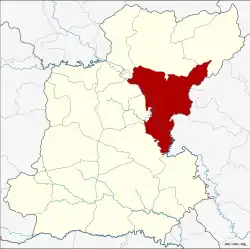Selaphum
เสลภูมิ | |
|---|---|
 District location in Roi Et province | |
| Coordinates: 16°2′0″N 103°56′2″E / 16.03333°N 103.93389°E | |
| Country | Thailand |
| Province | Roi Et |
| Area | |
| • Total | 792.338 km2 (305.923 sq mi) |
| Population (2005) | |
| • Total | 122,100 |
| • Density | 154.1/km2 (399/sq mi) |
| Time zone | UTC+7 (ICT) |
| Postal code | 45120 |
| Geocode | 4510 |
Selaphum (Thai: เสลภูมิ, pronounced [sěː.lā.pʰūːm]) is a district (amphoe) in the eastern part of Roi Et province, northeastern Thailand.
Geography
Neighboring districts are (from the south clockwise): Phanom Phrai, At Samat, Thung Khao Luang, Thawat Buri, Chiang Khwan, Pho Chai, Phon Thong, and Nong Phok of Roi Et Province; Kut Chum, Sai Mun and Mueang Yasothon of Yasothon province.
History
The Selaphum District was originally named 'Ban Khao Din Bueng Don' (บ้านเขาดินบึงโดน), which is believed been the name of a village. It was named after an island in the large swamp Bueng Don.
In 1879 Mueang Selaphum Nikhom (เสลภูมินิคม) was created. In 1912 it was renamed Selaphum, and converted into a district in 1914.
Khwan Mueang (Selaphum)
Khwan Mueang (ขวัญเมือง) sub-district is considered the main settlement in the Selaphum District.
The town is considered an old commercial area of the Selaphum district, many of the constructed buildings are commercial in the style of wooden structures, one-story and two-story in height with distinctive styles and specific architectural elements such as doors, balustrades and air vents above the door.[1] Some of these buildings can be dated to the early to mid 20th century.[1]
From the past to the present the town has been a trading community and historically residence of Chinese merchants who were also present at Yasothon.[1]
Administration
The district is divided into 18 sub-districts (tambons), which are further subdivided into 235 villages (mubans). Klang is a township (thesaban tambon) which covers tambon Klang and parts of tambons Na Mueang and Khwan Mueang. There are a further 16 tambon administrative organizations (TAO).
| No. | Name | Thai name | Villages | Pop. | |
|---|---|---|---|---|---|
| 1. | Klang | กลาง | 11 | 7,212 | |
| 2. | Na Ngam | นางาม | 16 | 8,372 | |
| 3. | Mueang Phrai | เมืองไพร | 14 | 6,498 | |
| 4. | Na Saeng | นาแซง | 14 | 5,824 | |
| 5. | Na Mueang | นาเมือง | 20 | 10,332 | |
| 6. | Wang Luang | วังหลวง | 18 | 6,291 | |
| 7. | Tha Muang | ท่าม่วง | 11 | 5,039 | |
| 8. | Khwao | ขวาว | 16 | 9,371 | |
| 9. | Pho Thong | โพธิ์ทอง | 14 | 7,931 | |
| 10. | Phu Ngoen | ภูเงิน | 18 | 12,061 | |
| 11. | Ko Kaeo | เกาะแก้ว | 14 | 7,611 | |
| 12. | Na Loeng | นาเลิง | 10 | 4,933 | |
| 13. | Lao Noi | เหล่าน้อย | 10 | 5,741 | |
| 14. | Si Wilai | ศรีวิลัย | 11 | 4,725 | |
| 15. | Nong Luang | หนองหลวง | 9 | 3,024 | |
| 16. | Phon Sawan | พรสวรรค์ | 9 | 4,456 | |
| 17. | Khwan Mueang | ขวัญเมือง | 11 | 6,582 | |
| 18. | Bueng Kluea | บึงเกลือ | 9 | 6,097 |
References
- 1 2 3 "แหล่งศิลปกรรมอันควรอนุรักษ์ - สิ่งแวดล้อมศิลปกรรม". culturalenvi.onep.go.th. Retrieved 2023-06-20.